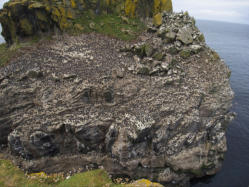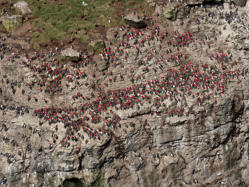
COUNTING THE GUILLEMOTS ON HARP ROCK
The visitor to Lunga is presented by two phenomina -
Puffins on the terraces and their amazing habituation to human presence.
The noise of the bird city that is Harp Rock.
The numbers of Guillemots now exceeds 10,000, and the birds now seem to occupy an almost contiual band around
the east and north faces.
We carry the count out on the first dry morning of our stay in late June as by the end of the week, birds and chicks
are leaving the colony.
Counting used to be done by reference to physical features but as the colony has grown such features no longer easily
enable the counter to create distinct groups to facilitate a visual count of the whole colony. Individual ledges on the lower
north face would still allow that, but photographs are used as a storable medium for any future reference.
This has resulted in the count being done by use of many photographs, making a patchwork quilt effect to cover
the whole colony with special care not to double count.
The group strives to keep a consistant level of accuracy. Photographs are usually taken on an equivalent of 80-100mm
in full-frame terms, on a 20 mega-pixel OM camera.
Images are the put up on to a computer monitor, and a coloured dot about the size of a guillemots head is put on each bird.
Parts of a bird are regularly marked (part of a wing, a head or neck) as many birds are partially hidden.
To enable this, it is usual to work with the image enlarged to 80-100% to get the detail needed.
Care must be taken to ignore Razorbills - looking out for the nearer black of that species compared to the greyer
Guillemot and longer white wing bar, as well as larger Guillemot chicks. The dots for each image are then counted by
the computer and summarised.
Recent increases in the population are illustrated here:
(click on each photo to expand)
2013
2024


C
C
Count Example (783 birds counted)

April 2025





















